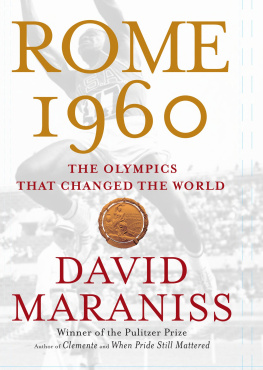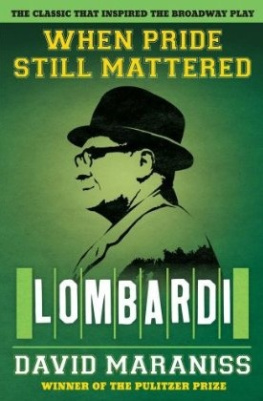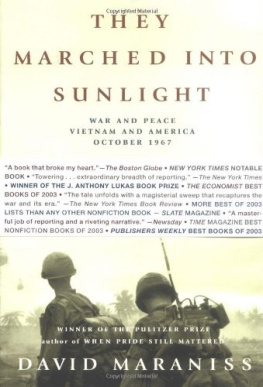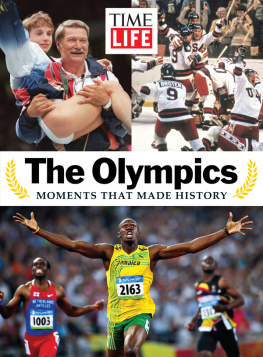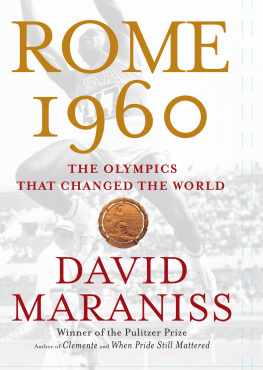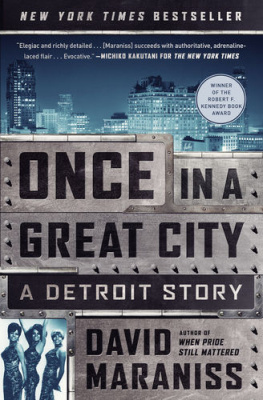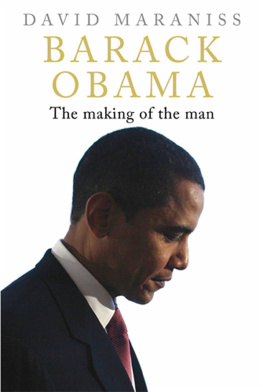David Maraniss - Rome 1960: The Olympics That Changed the World
Here you can read online David Maraniss - Rome 1960: The Olympics That Changed the World full text of the book (entire story) in english for free. Download pdf and epub, get meaning, cover and reviews about this ebook. year: 2008, publisher: Simon & Schuster, genre: Detective and thriller. Description of the work, (preface) as well as reviews are available. Best literature library LitArk.com created for fans of good reading and offers a wide selection of genres:
Romance novel
Science fiction
Adventure
Detective
Science
History
Home and family
Prose
Art
Politics
Computer
Non-fiction
Religion
Business
Children
Humor
Choose a favorite category and find really read worthwhile books. Enjoy immersion in the world of imagination, feel the emotions of the characters or learn something new for yourself, make an fascinating discovery.
- Book:Rome 1960: The Olympics That Changed the World
- Author:
- Publisher:Simon & Schuster
- Genre:
- Year:2008
- Rating:3 / 5
- Favourites:Add to favourites
- Your mark:
- 60
- 1
- 2
- 3
- 4
- 5
Rome 1960: The Olympics That Changed the World: summary, description and annotation
We offer to read an annotation, description, summary or preface (depends on what the author of the book "Rome 1960: The Olympics That Changed the World" wrote himself). If you haven't found the necessary information about the book — write in the comments, we will try to find it.
Rome 1960: The Olympics That Changed the World — read online for free the complete book (whole text) full work
Below is the text of the book, divided by pages. System saving the place of the last page read, allows you to conveniently read the book "Rome 1960: The Olympics That Changed the World" online for free, without having to search again every time where you left off. Put a bookmark, and you can go to the page where you finished reading at any time.
Font size:
Interval:
Bookmark:

Clemente: The Passion and Grace of Baseballs Last Hero
They Marched Into Sunlight: War and Peace,
Vietnam and America, October 1967
When Pride Still Mattered: A Life of Vince Lombardi
First in His Class: The Biography of Bill Clinton
The Clinton Enigma
The Prince of Tennessee: Al Gore Meets His Fate
(with Ellen Nakashima)
Tell Newt to Shut Up! (with Michael Weisskopf)

SIMON & SCHUSTER
1230 Avenue of the Americas
New York, NY 10020
Copyright 2008 by David Maraniss
All rights reserved, including the right to reproduce this book or portions thereof in any form whatsoever. For information, address Simon & Schuster Subsidiary Rights Department, 1230 Avenue of the Americas, New York, NY 10020.
SIMON & SCHUSTER and colophon are registered trademarks of Simon & Schuster, Inc.
Library of Congress Cataloging-in-Publication Data
Maraniss, David.
Rome 1960: the Olympics that changed the world / David Maraniss. 1st Simon & Schuster hardcover ed.
p. cm.
1. Olympic Games (17th: 1960: Rome, Italy) 2. OlympicsPolitical aspects. 3. OlympicsSocial aspects. 4. Cold War. I. Title.
GV7221960 .M37 2008
796.48dc22 2008013013
ISBN-13: 978-1-4391-0267-1
ISBN-10: 1-4391-0267-8
Visit us on the World Wide Web:
http://www.SimonSays.com
To Linda, my quirky saint
T HIS book is shaped around eighteen days in the summer of 1960 when the Olympics came to Rome. In the history of the modern Games, other times and places have drawn more notice, but none offers a deeper palate of character, drama, and meaning. The contests in Rome shimmered with performances that remain among the most golden in athletic history, from Wilma Rudolph in the sprints to Abebe Bikila in the marathon; from Cassius Clay in the boxing ring to Rafer Johnson in the decathlon. But beyond that the forces of change were everywhere. In sports, culture, and politicsinterwoven in so many waysone could see an old order dying and a new one being born. With all its promise and trouble, the world as we see it today was coming into view.
Television, money, and drugs were bursting onto the scene, altering everything they touched. Old-boy notions of pristine amateurism, created by and for upper-class sportsmen, were crumbling in Rome and could never be taken as seriously again. Rome brought the first commercially broadcast Summer Games, the first doping scandal, the first runner paid for wearing a certain brand of track shoes. New nations and constituencies were being heard from, with increasing pressure to provide equal rights for blacks and women as they emerged from generations of discrimination and condescension.
The singular essence of the Olympic Games is that the world takes the same stage at the same time, performing a passion play of nations, races, ideologies, talents, styles, and aspirations that no other venue, not even the United Nations, can match. The 1960 Games came during a notably anxious period in cold war history; almost every action in Rome was viewed through the political lens of those tense times.
One week before the Opening Ceremony, a Moscow trial brought the conviction of an American pilot, Francis Gary Powers, on espionage charges after his high-altitude U-2 reconnaissance plane was shot down over Soviet territory. Two days before the Closing Ceremony, Soviet Premier Nikita Khrushchev set sail for New York for a dramatic appearance at the U.N. General Assembly, where he pounded his fist and railed against America and the West. In between, even as athletes from East and West Germany competed as a unified team in Rome, officials in East Berlin closed their border temporarily, laying the first metaphorical bricks for what months later would become the all-too-real Berlin Wall.
The pressures of the cold war played an underappreciated role in forcing change in culture and sports, all much in evidence in Rome. At the opening Parade of Nations at the Stadio Olimpico, the crowd was stirred by the sight of Rafer Johnson marching into the arena at the head of the U.S. delegation, the first black athlete to carry the American flag. Johnsons historic act reflected his un-surpassed status as a world-class decathlete, but it also served as a symbolic weapon at a time when the United States was promoting freedom abroad but struggling to answer blatant racism at home, where millions of Americans were denied freedom because of the color of their skin. One of the new battlegrounds in the cold war was black Africa, where fourteen nations came into being that year. The ambitions of a postcolonial world were played out at the Olympics when marathoner Abebe Bikila of Ethiopia became the first athlete from sub-Saharan Africa to win a gold medal, running barefoot through the Roman streets less than a quarter century after Italy had invaded his homeland.
Early formulations of the individualism that came to define the sixties could also be seen in Rome, most notably in a cocky German sprinter, Armin Hary, and an eighteen-year-old light-heavyweight boxer from Louisville named Cassius Marcellus Clay, whose gold medal performance marked the first step onto the world stage of a character soon to gain renown as Muhammad Ali. And finally, it was at the 1960 Olympics that American women athletes took a more prominent role. Sexism still dominated the Olympic Movement, as it did the entire world of sports, but the realities of the cold war helped force progress for the simple reason that success of U.S. women could boost the medal count versus the Soviets. On the Stadio Olimpico track, in the late-summer heat, the rise of women was helped immeasurably by the radiance of sprinter Wilma Rudolph and the Tigerbelles, who came out of Coach Ed Temples little program at Tennessee State University to capture the worlds admiration and inspire women athletes for generations thereafter.
It is with the Tigerbelles and Rafer Johnson, two years before Rome, that the story begins.
D ARKNESS fell slowly in midsummer Moscow, but the Americans arrived so late that the chartered buses needed headlights to illumine the ride from the airport. Every now and then, for no readily apparent reason, the Russian drivers clicked off the lights, drove a few blocks through the crepuscular murk, then turned on the beams again. The most mundane events can be charged with mystery the first time around, and this was a first for the passengers entering the Soviet capital on the Monday evening of July 21, 1958. They were members of the first U.S. track-and-field team to visit the USSR since the start of the cold war. Out the windows, flashes of light and shadow flitted by, a hypnotic passing scene: drunken men slouched in dimly lit doorways; armed soldiers at intersections; broad avenues with little traffic other than buses whose exhaust fumes fouled the humid air; and the occasional black sedan claiming the VIP lane. When the Americans reached their hotel and checked into their rooms, they were struck by how heavy everything seemed. Bulky bedposts and thick, ponderous curtains.
Edward Stanley Temple had seen worse back home. As someone who had spent a lifetime dealing with alien environments because of his skin color alone, this one was not quite so unnerving. Moscow, to him, was just a stop on the road, another way for the coach and his athletes to get where he wanted them to go, past Russia and into history at the 1960 Olympic Games in Rome.
This leg of Temples improbable journey had begun three weeks earlier with a gesture of audacious confidence. As he was preparing to leave his home in Nashville for the Fourth of July weekend, he asked his wife, Charlie, to pack his suitcase with enough clothes for him to spend several weeks overseas. The request surprised her, since the schedule called for Temple, the womens track coach at Tennessee Agricultural and Industrial State University, to be away for only four days at the national championships in Morristown, New Jersey. That was just the first stop, he explained. Although nothing had been decided yet, he predicted that he and his Tigerbelles would be chosen to go from there all the way across the Atlantic for the first-ever dual track meet between the United States and the Soviet Union.
Font size:
Interval:
Bookmark:
Similar books «Rome 1960: The Olympics That Changed the World»
Look at similar books to Rome 1960: The Olympics That Changed the World. We have selected literature similar in name and meaning in the hope of providing readers with more options to find new, interesting, not yet read works.
Discussion, reviews of the book Rome 1960: The Olympics That Changed the World and just readers' own opinions. Leave your comments, write what you think about the work, its meaning or the main characters. Specify what exactly you liked and what you didn't like, and why you think so.

